

<< Go Back up to Region ‘California (outside Los Angeles and San Francisco)’
| Follow Mike Hume’s Historic Theatre Photography: |  |
 |
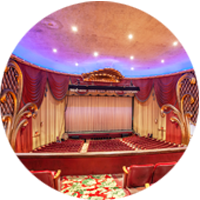
Architects: S. Charles Lee (original design), Carl G. Moeller (1950s alterations)
Atmospheric Style: Spanish Courtyard (later restyled)
First Opened: 25th December 1930 (95 years ago)
Reopened: 1st May 1953
Reopened: October 1994
Former Names: Fox Theatre
Website: thebakersfieldfox.com 
Telephone: (661) 324-1369 
Address: 2001 H Street, Bakersfield, CA 93301 
The Fox Theatre in Bakersfield opened on Christmas Day in 1930, as an atmospheric theatre with a Mediterranean village theme. In 1953 the auditorium was given a Skouras-style makeover, and today it remains one of the best preserved examples of this mid-century movie theatre style.

 Detailed Information
Detailed Information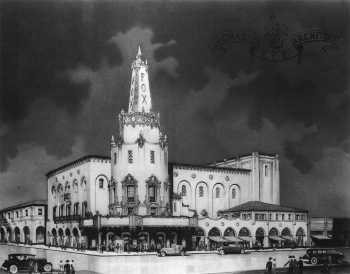
Architect S. Charles Lee originally envisioned the theatre anchoring a major retail center in downtown Bakersfield with open arcades at street level, however ultimately plans were scaled-back.
Ground was broken in late December 1929 and the theatre predicted was to cost $250,000; costs ultimately rose to $325,000 by the time of completion.
Lee designed the building in Spanish Colonial Revival style with mission-style tiles on the roof and white stucco walls. The building’s focal point is its eye-catching clock tower, positioned at a major intersection downtown and thus visible from the cardinal points in all directions.
The clock tower features Churrigueresque detailing around the lower windows, slender slot windows accentuating the height of the tower, “FOX” neon signage above, and large neon-lit clock faces at the top sitting just below a ornamental dome with a wind vane (weathercock) on the top.
The Fox was built primarily as a movie theatre but included stage facilities (full height scenery flying, dressing rooms, orchestra pit, etc) for vaudeville and stage presentations.
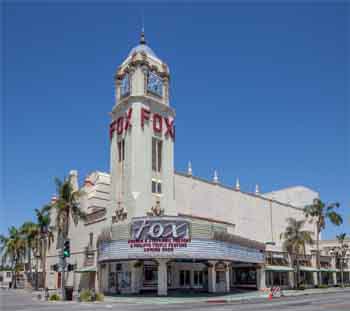
The building was somewhat scaled-down from the original plans, which called for a taller and more prominent clock tower. The lower part of the clock tower would have housed office space in an octagonal space.
The building was executed in poured concrete over steel, allowing it to withstand the 1952 Kern County earthquake (M7.3) that saw many other downtown Bakersfield buildings seriously damaged and subsequently demolished. The theatre suffered no major damage.
The lobby features dramatic sloping concrete beams, supporting the balcony, which were originally painted with stenciled geometric designs. The main floor level of the lobby featured murals depicting historic events in the history of California, along with tapestries, paintings, and maps.
The lobby stairs, rising up to the balcony level promenade overlooking the main lobby, originally featured a window to view the new and modern air chilling equipment installed in the theatre. This viewport was covered-up with a poster display area likely in the 1950s.

An original 1930s followspot, as used in the theatre, has been made a feature in the upper lobby. Also featured in this area are original “FOX” wooden chairs, still in situ from the theatre’s opening in 1930.
The 1,500-seat auditorium was originally designed in an atmospheric style, best described as “an escape to exoticism” and intended to transport patrons to a far-distant land, watching a performance al fresco under a starry sky with clouds lazily drifting past. The Fox featured a Mediterranean village theme, similar to the Arlington Theatre in Santa Barbara. The interior designer was Los Angeles-based, Brussels-born, Emil T. Mazy, who is well-known for painting the huge yet delicate murals of the Spreckels Theatre in San Diego.
The proscenium was flanked on either side by a trio of pillars mounted on large pedestal bases, supporting a dominant ante-proscenium reminiscent of a Spanish Mission, topped with a shallow sloping tiled roof. The Fox was designed with the Fox Grandeur process in mind, and as such the proscenium was an important framing device for the-then newer widescreen format.
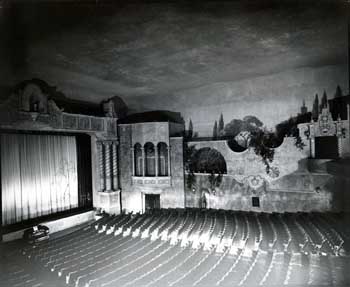
Large building façades featuring imposing asymmetrical designs stood on either side of the proscenium, their large bulk hiding the organ chambers within. The rest of the auditorium sidewalls featured asymmetrical simulated buildings and ornamental walls draped with ivy, behind which were murals of rural Spanish countryside scenes painted onto the sidewalls giving way to the sky above, complete with twinkling stars and projected moving clouds. The whole affair was lit with hidden cove lighting and allowed for differing moods to be created, such as a sunset for warmth in the winter and blues during the hot summers to suggest coolness.
_thumb.jpg)
As was common with theatres of the time, the Fox had a Brenograph. These complex light projection machines, manufactured by the Brenkert Light Projection Company, were advertised as “Projecting Everything but the Picture”. They were most commonly used in atmospheric theatres to project moving clouds or other weather effects onto the “sky” auditorium ceiling. Brenographs were extremely versatile and could be used to project almost anything, from tableau scenes to song sheet sing-a-long words, animated effects, and enhancing the main feature presentation with color and/or surrounding projections. The Fox had the ultimate model, the F7 Master Brenograph, and as of early 2022 it is still in the theatre. It is not operational but it is in exceedingly good shape and ready for renovation, which the Fox Theater Foundation is planning for in its future strategy.
The theatre opened with a pipe organ to accompany silent movies and to provide entertainment during the intermissions of sound movies. According to robertmorton.org  the original organ was a Robert Morton 2-manual, 16-rank pipe organ. It is unknown when the organ was removed from the theatre, but it was certainly gone by the 1953 remodel and its removal probably aligned with that date.
the original organ was a Robert Morton 2-manual, 16-rank pipe organ. It is unknown when the organ was removed from the theatre, but it was certainly gone by the 1953 remodel and its removal probably aligned with that date.
Fox West Coast Theatres entered into bankruptcy in late 1933 and the theatre chain was sold to the National Theatres Corporation, led by Charles P. Skouras, one of the immigrant Skouras Brothers who came to the U.S. from Greece and would ultimately make their fortune in the Hollywood movie industry. The Fox was a first-run movie theatre for many years under the Skouras Brothers’ direction.

The Fox closed in late November 1952 to undergo a thorough renovation, as did some 200 Fox theatres on the U.S. West Coast under the control of the Skouras Brothers during the late 1940s and early 1950s. The style is best described as Art Moderne meets Streamline, utilizing a mix of heavy Art Deco and light rococo forms of gilded ornamentation, with monumental ornament and heavy use of swags and drapery. Skouras’ designer Carl G. Moeller gave the Fox a more modern, attractive theme at a time when movie theatres were battling against television to attract viewers. The newly-decorated Fox reopened 1st May 1953 with a gala event.
Unlike most other theatres, this mid-1950s treatment has not been partially or fully reversed over time and the Fox retains its full Skouras-style treatment. The only other well preserved Skouras-style movie theatres which are still operating are the Crest Theatre  in Sacramento (built in the Skouras style) and the Babcock Theatre
in Sacramento (built in the Skouras style) and the Babcock Theatre  in Billings, Montana, which like the Fox Bakersfield was remodeled from an earlier design.
in Billings, Montana, which like the Fox Bakersfield was remodeled from an earlier design.
Another aspect of the 1953 remodel saw a 45ft wide, 20ft tall (13.7m by 6.1m) widescreen projection screen added, called “Polorama”, accommodated by hacking-out the ornamental plasterwork sides of the original proscenium arch. This was a common approach to the 1950s modernization of movie theatres, and the Fox was not alone in the partial destruction of its original décor to accommodate changing tastes and technologies. Film projectors were also upgraded. Front-of-House areas were updated as part of the modernization with a large concessions area being added. On the outside of the building a new marquee and Skouras-style box office were added on top of brightly-colored terrazzo laid into the sidewalk. The theatre reopened May 1st, 1953.
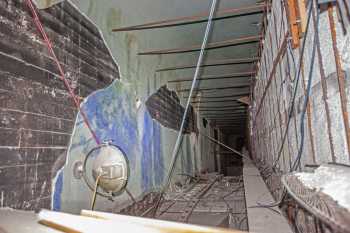
Behind some of the auditorium’s drapes there are remnants of Lee’s original theatre design including columns at either side of the proscenium, organ grilles, and plasterwork medallions. Parts of the original sidewall murals and hidden cove lighting scheme also survive.
Mann Theatres took over the theatre in 1973, and in 1977 the Fox was closed, the original intention being to convert it into a four-screen theatre. The conversion never materialized and the theatre sat dormant.
In 1979 the theatre was sold to the Martinez Family for $260,000. In 1984 they leased it to an operator who intended to reopen the theatre as a performing arts center, however aside from a few small events the cost to realize this ambitious goal proved prohibitive. The Fox sat dormant for a decade.
In 1994 the nonprofit Fox Theater Foundation was formed, led by Cathy Butler and the Bakersfield Downtown Business Association, and their “Save the Fox” campaign saved the theatre from demolition thanks to generous donations from over 380 supporters.
The Fox Theater Foundation purchased the borderline derelict theatre for $500,000 in June 1994. The theatre reopened in October 1994 and renovations were ongoing until 2002.

The interior of the clock tower was originally the furnace (heating) room for the theatre, with a huge fan pulling-in fresh air and gas burners heating the air before it was distributed around the auditorium. After the Fox Theater Foundation took on the theatre in 1994, the room was transformed by foundation board member Walt Koch into a new home for the renovated clock mechanism and a mini-museum.
The Concessions stand in the lobby is a recreation of the 1950s-era Concessions stand and was based on historic photos. The Fox Theater Foundation’s 1990s logo appears subtly on the rear wall of the Concessions stand, indicating its relatively modern provenance.
The theatre retains its original Dumbwaiter system which allows items to be delivered from the lobby at street level up to the Project Booth area. It passes through an office at the balcony lobby level. The Dumbwaiter is still used to transfer film cans containing 35mm prints up to the Projection Booth.
The Fox is now a busy live events center which hosts a variety of events ranging from movies to ballet, community events and contemporary pop and rock acts. As of early 2022 the Fox is seeking to reinstall an organ into the theatre.
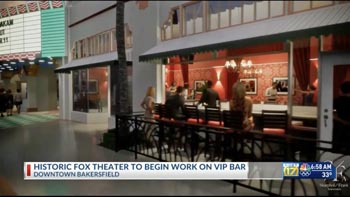
In early 2022 a plan was reported  to convert the long-dormant retail stores on the east side of the building into a VIP bar and performance space for ticket holders and special guests. The intent is that it will be a place to gather, socialize, and listen to live music – before, after, or during performances in the theatre next door.
to convert the long-dormant retail stores on the east side of the building into a VIP bar and performance space for ticket holders and special guests. The intent is that it will be a place to gather, socialize, and listen to live music – before, after, or during performances in the theatre next door.
Select artists who have appeared at the Fox over the years include B.B. King, Cyndi Lauper, Bernie Mac, Tony Bennett, Jamie Foxx, Huey Lewis and the News, the Moscow Russian Ballet, Tom Jones, George Lopez, Johnny Cash, Vince Vaughn, Olivia Newton-John, Bryan Adams, The Monkees, The B52’s, Ice Cube, the Glenn Miller Orchestra, and Kevin Hart.
 Movie, TV & Music Video Appearances
Movie, TV & Music Video Appearances . The exterior of the Fox Theater features prominently in the video.
. The exterior of the Fox Theater features prominently in the video. Videos from our YouTube channel:
Videos from our YouTube channel: Listed/Landmark Building Status
Listed/Landmark Building Status How do I visit the Fox Theater Bakersfield?
How do I visit the Fox Theater Bakersfield?The Bakersfield Fox doesn’t currently offer tours so check out the theatre’s events calendar  for upcoming events.
for upcoming events.
 Further Reading
Further Reading contains a detailed history with many historic photographs, as well as calendar of events, online booking, and venue/technical information.
contains a detailed history with many historic photographs, as well as calendar of events, online booking, and venue/technical information.
 contains detailed booking history, reader comments, and additional photos.
contains detailed booking history, reader comments, and additional photos.
 .
. , by Chris Brewer, published by Historical Pub Network. ISBN 9781893619142.
, by Chris Brewer, published by Historical Pub Network. ISBN 9781893619142. Technical Information
Technical Information Photos of the Fox Theater Bakersfield
Photos of the Fox Theater BakersfieldPhotographs copyright © 2002-2026 Mike Hume / Historic Theatre Photos unless otherwise noted.
Text copyright © 2017-2026 Mike Hume / Historic Theatre Photos.
For photograph licensing and/or re-use contact us here  . See our Sharing Guidelines here
. See our Sharing Guidelines here  .
.
| Follow Mike Hume’s Historic Theatre Photography: |  |
 |